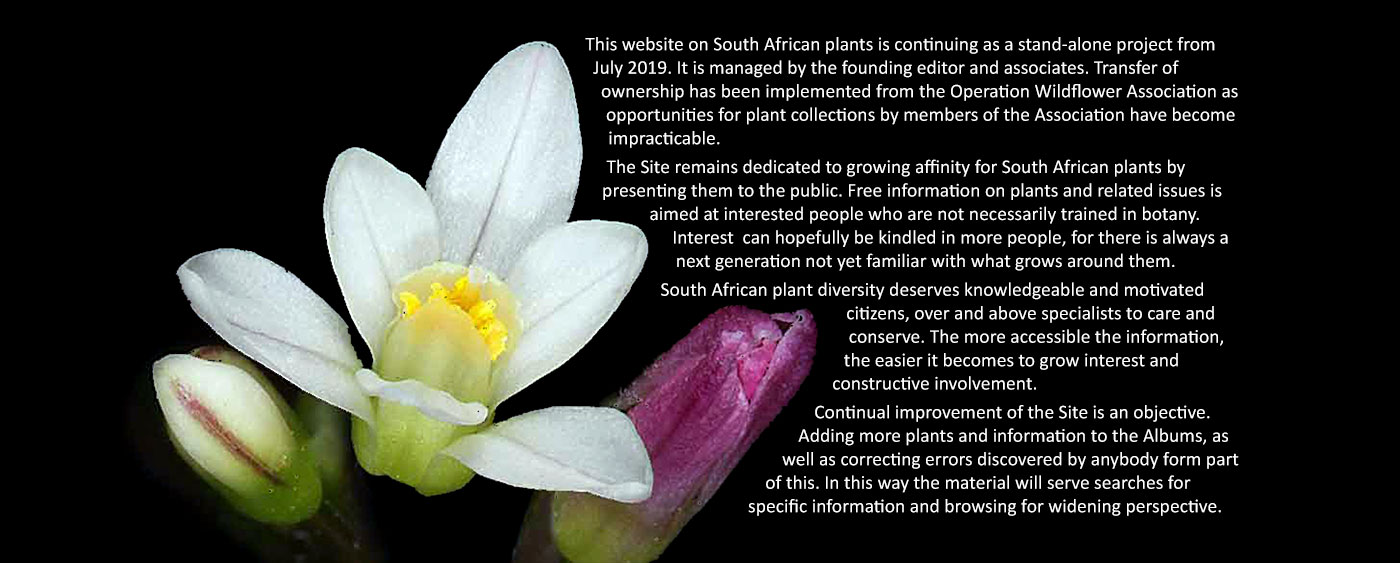

1. New Albums and some changes
The latest Albums on genera of South African plants added to the Operation Wildflower Site are the ones on Cyrtanthus, Dicoma and Strumaria. This means that photos and stories of plants belonging to these genera already on the Site, together with some new ones, have been moved from the more general Albums called Bulbs and Herbs respectively into their own new Albums under Genera.
There is a genus Album in every case where enough material has been accumulated to warrant a stand-alone grouping of photos and stories. There are now more than 220 such genera Albums. The biggest ones (most photos) belong to the genera Crassula, Euphorbia, Pelargonium, Aloe and Erica. Keep watching, more will be added. If there is no genus Album yet on the plant you are looking for, check under Types, the grouping that the Site was started off with, accessible via the pictured items shown on the right. The Search Box may yield more, for plants and related material are also shown in Albums on Habitat, Regions and Parks and Gardens.
In order to access items on a plant of interest, enter its botanical name in the Search Box. Entering other words or names will access what is contained in the Albums database. The latest Regions Album is the one on Nature's Valley and the latest Parks and Gardens Album is on Tietiesbaai also known as the Cape Columbine Nature Reserve.
2. Want to talk about a plant or an Album item?
There is a new way of communicating with the Editor of this Site regarding any of the Album Items.
Comments, questions, corrections, information and suggestions can be put to the Editor by using the following email address: This email address is being protected from spambots. You need JavaScript enabled to view it..
Please ensure that the Album Item concerned is clearly identified. Type its exact title as well as the Album Name in the Subject Line of your email. Please also state your name.
Similarly, communication regarding the functioning or technical aspects of the Site can be directed to the Webmaster at: This email address is being protected from spambots. You need JavaScript enabled to view it..
3. Reduced Mobile Site for Cell Phone Users
Operation Wildflower now also offers a reduced Mobile Site for cell phone use that only presents the Albums contents. This is aimed at overcoming display difficulties on some of the mobile devices in use for quick reference. The reduction found in the Mobile Site doesn't affect the full set of photos and stories of Operation Wildflower, only in diminishing the Site's secondary details that may make it hard to access the items on a small screen.
It is best to use the normal or full Operation Wildflower Site on computers, iPads and devices with bigger screens, as well as those that present unimpaired display of full details and access to all material on offer.
Should viewing difficulties be experienced on your device, click here to access the Mobile Site.
4. Subject Index
A Subject Index of a selection of topics touched on in Album Item text has been started, other than plant species. Access it via Information.
The Album Item Title should be clicked upon to open the Item dealing with the Topic.
Check in the Search Box for yet more subjects not added to the Subject Index list yet.
|
Botanical name |
Aloe verecunda |
|
Other names |
|
|
Family |
Asphodelaceae |
|
Dimensions |
A small, erect grass aloe, often deciduous, growing to 30cm, solitary or in groups |
|
Description of stem |
Lowest (outer) parts of the leaves show characteristic white spots; winter grass fires or the cold leaves just the short stem visible, until the new leaves sprout annually in spring |
|
Description of leaves |
Narrow blue-green leaves arranged in two ranks or narrowly fan-shaped, sometimes developing into a circular rosette arrangement in older plants; the leaves covered with many raised, wartlike white spots on the outer surface near the base; small soft teeth on the edges (only); dying back in harsher winter weather |
|
Description of flowers |
Capitate, single racemes appear in summer, deep pink to red flowers, pendulous upon opening, perianth green at the mouth |
|
Desciption of seed/fruit |
|
|
Description of roots |
Thick fleshy roots where water is stored in winter when it is normally leafless |
|
Variation |
A greenish flower form exists in the Limpopo Province |
|
Propagation and cultivation |
Grown from seed, do well in sunny rockery environments with well-drained soil; unlike many other grass aloes, A. verecunda thrives in full sun; transplanting is harmful to the root system that takes a long time to recover |
|
Tolerances |
|
|
Uses |
Garden plant, advertised on the international market |
|
Ecological rarity |
Not common anymore in the natural habitat, becoming threatened through habitat destruction and degradation? |
|
Pests and diseases |
|
|
Other |
CITES (and local provincial) restrictions on removal, transplanting and even seed collection of SA grass aloes without authorisation (See www.gisa.co.za); A. verecunda can be seen on the Melville Koppies |
|
Location |
Rocky outcrops and mountainous slopes, in grassland |
|
Distribution (SA provinces) |
Gauteng, Mpumalanga, Limpopo |
|
Country |
South Africa |







